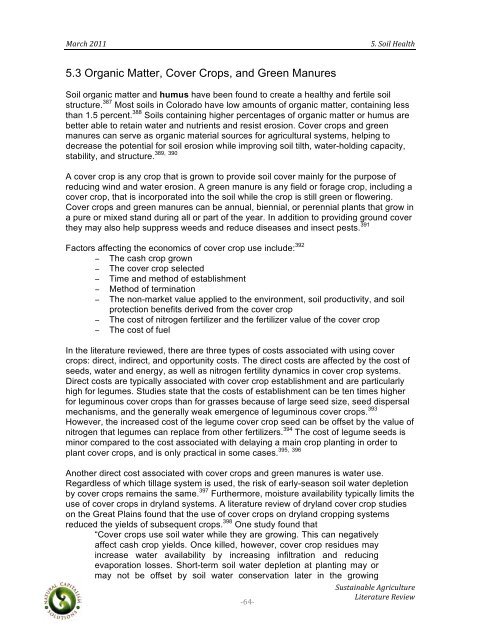Sustainable Agriculture Literature Review - Boulder County
Sustainable Agriculture Literature Review - Boulder County
Sustainable Agriculture Literature Review - Boulder County
You also want an ePaper? Increase the reach of your titles
YUMPU automatically turns print PDFs into web optimized ePapers that Google loves.
! !!<br />
"#$%&!'())!! !!!!!!!!!!!!!!!!!!!!!!!!!!!!!!!!!!!!!!!!!!!!!!!!!!!!!!!!!!!!!!!!!!!!!!!!!*+!,-./!01#/2&!<br />
5.3 Organic Matter, Cover Crops, and Green Manures<br />
Soil organic matter and humus have been found to create a healthy and fertile soil<br />
structure. 387 Most soils in Colorado have low amounts of organic matter, containing less<br />
than 1.5 percent. 388 Soils containing higher percentages of organic matter or humus are<br />
better able to retain water and nutrients and resist erosion. Cover crops and green<br />
manures can serve as organic material sources for agricultural systems, helping to<br />
decrease the potential for soil erosion while improving soil tilth, water-holding capacity,<br />
389, 390<br />
stability, and structure.<br />
A cover crop is any crop that is grown to provide soil cover mainly for the purpose of<br />
reducing wind and water erosion. A green manure is any field or forage crop, including a<br />
cover crop, that is incorporated into the soil while the crop is still green or flowering.<br />
Cover crops and green manures can be annual, biennial, or perennial plants that grow in<br />
a pure or mixed stand during all or part of the year. In addition to providing ground cover<br />
they may also help suppress weeds and reduce diseases and insect pests. 391<br />
Factors affecting the economics of cover crop use include: 392<br />
! The cash crop grown<br />
! The cover crop selected<br />
! Time and method of establishment<br />
! Method of termination<br />
! The non-market value applied to the environment, soil productivity, and soil<br />
protection benefits derived from the cover crop<br />
! The cost of nitrogen fertilizer and the fertilizer value of the cover crop<br />
! The cost of fuel<br />
In the literature reviewed, there are three types of costs associated with using cover<br />
crops: direct, indirect, and opportunity costs. The direct costs are affected by the cost of<br />
seeds, water and energy, as well as nitrogen fertility dynamics in cover crop systems.<br />
Direct costs are typically associated with cover crop establishment and are particularly<br />
high for legumes. Studies state that the costs of establishment can be ten times higher<br />
for leguminous cover crops than for grasses because of large seed size, seed dispersal<br />
mechanisms, and the generally weak emergence of leguminous cover crops. 393<br />
However, the increased cost of the legume cover crop seed can be offset by the value of<br />
nitrogen that legumes can replace from other fertilizers. 394 The cost of legume seeds is<br />
minor compared to the cost associated with delaying a main crop planting in order to<br />
395, 396<br />
plant cover crops, and is only practical in some cases.<br />
Another direct cost associated with cover crops and green manures is water use.<br />
Regardless of which tillage system is used, the risk of early-season soil water depletion<br />
by cover crops remains the same.<br />
!,342#.5#6/1!78$.%3/23$1!<br />
9.21$#23$1!:1;.1
















